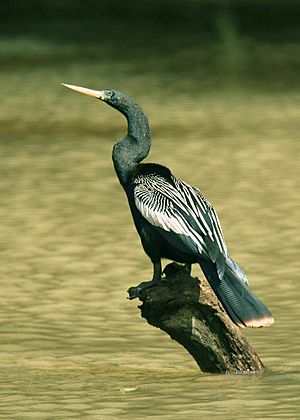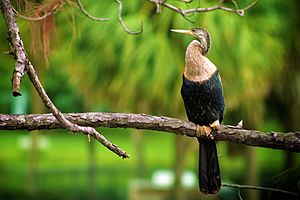Anhinga facts for kids
Quick facts for kids Anhinga |
|
|---|---|
 |
|
| Male in Costa Rica | |
| Conservation status | |
| Scientific classification | |
| Genus: |
Anhinga
|
| Species: |
anhinga
|
| Subspecies | |
|
A. a. anhinga |
|
 |
|
| Range of A. anhinga Breeding range Resident range | |
| Synonyms | |
|
Plotus anhinga Linnaeus, 1766 |
|
The Anhinga (Anhinga anhinga) is a cool water bird found in the warmer parts of the Americas. People sometimes call it the snakebird or water turkey. The name "anhinga" comes from a Brazilian language called Tupi language. It means "devil bird" or "snake bird".
You can see why it's called a snakebird when it swims. Only its long neck sticks out of the water. This makes it look like a snake ready to strike! Anhingas are part of the darter family. They are related to darters found in Asia, Africa, and Australia. Like other darters, the anhinga catches fish and other small animals. It uses its sharp, thin beak to spear them.
Contents
Where Do Anhingas Live?
Anhingas live all over the world in warm, shallow waters. The American anhinga has two main types, or subspecies. One type, A. a. anhinga, lives mostly in South America. You can find it east of the Andes mountains and on the islands of Trinidad and Tobago.
The other type, A. a. leucogaster, lives in the southern United States and Mexico. It also lives in Cuba and Grenada. Anhingas usually stay in their warm homes. But some birds that live in very northern or southern areas will migrate. They move to warmer places during winter. This helps them stay warm when the sun isn't as strong.
What Do Anhingas Look Like?
Anhingas are large birds. They are about 89 centimeters (35 inches) long. Their wings can spread out to about 1.14 meters (3.7 feet) wide. They usually weigh around 1.22 kilograms (2.7 pounds). Their beak is long, pointed, and yellow. Their webbed feet are also yellow.
Male anhingas are shiny black-green. Their wings and tail are a glossy black-blue. The tips of their tail feathers are white. The feathers on the back of their head and neck are long. They can look gray or light purple-white. Their upper back and wings have white spots or streaks.
Female anhingas look similar to males. But their head, neck, and upper chest are a pale gray-buff or light brown. Their lower chest is a chestnut color. Females also have a browner back than males.
Baby anhingas are born without feathers. But they quickly grow soft tan down. After a few weeks, this tan down turns white. Then their first real feathers start to grow. Young anhingas are mostly brown. They stay this color until they are old enough to have their own babies. This usually happens after their second or third winter.
People sometimes confuse anhingas with double-crested cormorants. This is because they are similar in size and shape. But you can tell them apart by their tails and beaks. Anhingas have a wider and much longer tail. Cormorants have a hooked beak, while anhingas have a pointed one.
How Do Anhingas Behave?
Anhingas use their webbed feet to swim underwater. They chase fish and spear them quickly with their long necks. Then they bring the fish to the surface to eat them.
Unlike ducks or pelicans, anhingas do not have waterproof feathers. Their feathers get completely wet when they dive into the water. This means they cannot float on the water for a long time. Their heavy bones and wet feathers help them sink. This allows them to swim deep underwater to hunt for food.
Anhingas cannot fly well when their feathers are wet. If they try to fly, they flap their wings hard. They also "run" on the water to get enough speed. To dry their feathers, anhingas stand with their wings spread wide. They fan their feathers open in a half-circle shape. They face away from the sun to help their feathers dry faster. This pose also helps them soak up heat from the sun. It helps them warm up after being in the cool water. Because of this drying pose, an anhinga can look like a male turkey. This is why some people call them "water turkeys."
What Do Anhingas Eat?
Anhingas mostly eat medium-sized fish from wetlands. In places like Alabama, they eat fish such as Mullet (fish), sunfish, and catfish. They also eat crayfish, crabs, shrimp, water insects, tadpoles, water snakes, and small turtles. In Florida, they mainly eat sunfish, bass, and other small fish.
Anhingas hunt fish underwater, especially where there are plants. Once they find their prey, they partly open their beak. Then they quickly stab the fish. For bigger fish, they use both parts of their beak. For small fish, they use only the lower part. If a fish is too big to eat, the anhinga might stab it many times and then let it go. After catching a fish, anhingas bring it to the surface. They toss it into the air and swallow it head-first.
Conservation Status
The anhinga is a protected bird in the United States. It is protected under the Migratory Bird Treaty Act of 1918. There are many anhingas around the world. They live across a huge area, about 15 million square kilometers (5.8 million square miles). Because they are so common, they are considered a species of "least concern." This means they are not currently at risk of disappearing.
Images for kids
See also
 In Spanish: Aninga americana para niños
In Spanish: Aninga americana para niños









